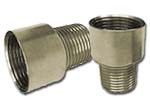lakee911
Senior Member
- Location
- Columbus, OH
We specify, in our spec, a minimum of 3/4" conduit. A lot of instruments have only 1/2" NPT conduit/cable entry locations. In this case, the Contractor uses an adaptor and connects up 3/4" conduit or flex.
If we have a case as stated above and the conduit fill is too high for 1/2" conduit, but fine for 3/4" conduit, would it be a code violation?
In other words, is the conduit fill code enforced for a very small opening of very short length?
Thanks,
Jason
If we have a case as stated above and the conduit fill is too high for 1/2" conduit, but fine for 3/4" conduit, would it be a code violation?
In other words, is the conduit fill code enforced for a very small opening of very short length?
Thanks,
Jason


